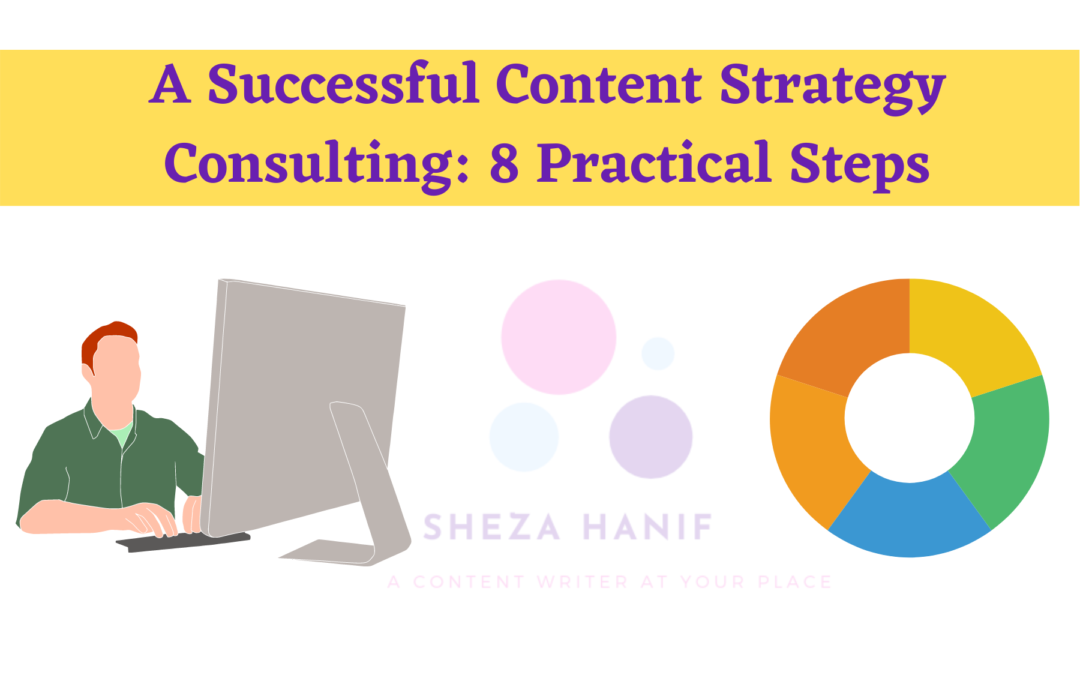This guide will share eight steps you need to follow to create a content strategy consulting you can build on.
We see it too often: companies start with content marketing and then stop after a few months.
These are the most common arguments:
- I hired a content marketing agency to write content, but I do not see any results.
- I have created a lot of content myself, but nothing happens.
But where does it go wrong? Why are some companies so successful with content marketing and others not?
In most cases, it is the content strategy. Companies with successful content have formulated a clear content strategy.
A good content strategy consulting gives direction to everything you do.
Too many companies skip the strategy phase and focus on writing content for their website. But no matter how much content you create, you won’t magically generate leads if you don’t know what your goals are.
What exactly is content strategy consulting?
A content strategy is a strategic document. Here you record how you will use content marketing to gain the trust of your target group and convert them into paying customers.
In your content strategy, you define:
- what your goals are
- who is your target audience
- what kind of content you are going to create
- how, where, and when you will publish the content
Our definition of content strategy consulting.
With a content strategy, you build an audience. You do this by regularly publishing, updating, and sharing high-quality content. With this content, you know how to keep your audience. In this way, they eventually become interested in your product or service, and eventually, they become a customer.
How should you use this content strategy consulting roadmap?
In this guide, we share eight steps you need to follow to create a content strategy consulting. This is the same process we use for ourselves and our customers.
The first three steps will help you to:
- set goals
- map out your competitors
- capture your target audience
The following five steps will help you with:
- find a topic and conduct keyword research
- convert keywords and topics into concrete topics
- planning topics
- create content
- monitor progress
Step #1 – Set Goals
It all comes down to your goals.
When we ask customers about their content marketing goals, their answers determine the content strategy consulting we create for them.
The goal determines the strategy because the content is never the goal.
Defining content objectives seems simple. However, in practice, we often see that customers initially do not know the purpose of their content. Make sure your goals (KPIs) are concrete and measurable.
Example
We recently had a brainstorming session with a customer in which we jointly determined the content strategy consulting for the coming six months.
One of the marketers told me that they actually have a customer freeze but still want to keep blogging. In this way, they wanted to continue building organic positions and staying top of mind with the target group.
At first glance, that’s a great strategy. But when we inquired, it turned out that they were working behind the scenes on a digital course.
That is crucial information.
Because of that information, the strategy to build organic positions and stay top of mind is not the most exciting choice.
Suppose you know that you will be selling digital courses in time. In that case, you want to collect as many email addresses as possible and build a relationship until the digital approach is ready for launch.
And that requires different content because the goal determines the strategy.
Step #2 – Know who your competitors are
Competitors give you insight into the market and how you can position yourself there.
It is not only essential to know who your direct competitors are. You have to look more comprehensive than that: who or what can take prospects away from you?
For example, a personal trainer competes with other personal trainers and online weight loss programs or counseling apps. You can do in-depth competitor analysis with marketing tools. We use SEMrush, but there are several helpful tools available online.
Step #3 – Know who you are writing for
Then you determine your target audience.
This is a crucial step because the content that you will soon be creating will largely depend on what your target audience wants to see.
Identify and describe your target audience using a buyer persona, creating a buyer persona forces you to immerse yourself in your target audience.
By immersing yourself in them, you gain a wealth of information. For example, you learn what the most significant pain points and challenges of your target group are.
For instance:
- Amalia is a working mother who wants to cook healthy for her family but has too little time to cook every day.
- Frank is a personal injury lawyer who wants more clients. He would like to get started with SEO himself, but he doesn’t know where to start.
- Tony has received a small inheritance and wants to invest or invest his money. He has little experience and is afraid of making the wrong decision.
Depending on your products and services, you may have multiple target groups. You can even have numerous buyer personas per target group. That is why you have to delve into their pain points and challenges for each target group and persona.
Step #4 – Topic and Keyword Research
This is super important to realize: your potential customer is not necessarily looking for the solution you offer.
They are looking for a solution to their problem. You can (coincidentally) solve that.
The topics that are strongly related to your business are often the most valuable. But how do you know which topics and terms to use in your content so that your target group finds your company?
Through topic and keyword research
Most content marketers find this the minor fun part of content creation, but it is an important step. It is indispensable if you want to create easy-to-find content.
Before you start writing content, you first need to determine which search terms and questions your target audience is using. This is called keyword research. You need an SEO tool for that. We also use a paid variant of SEMrush for this, but you can also use a free tool. You can also hire an SEO agency.
Think of some keywords that are relevant to your target group and niche. Analyze one of your keywords with your SEO tool.
Example
One of our buyer personas is Amalia. Amalia is a working mother who wants to cook healthy for her family but has too little time to cook every day.
A keyword that is relevant to Amalia and related to your niche is ‘healthy food.’
If you analyze this keyword, you will get the following answers:
Now you’ve found some topics that give you the chance to dig deeper for information.
Do you have no idea which keywords are interesting? No stress. The solution is simpler than you think: look at what others in your industry are writing about.
You do this by analyzing the website of competitors.
Enter the URL of the website into the SEO tool, choose organic research, and select ‘root domain.’ You can analyze the website at keyword level or page level.
Analyzing the website at the page level will better understand the traffic that a particular page is bringing in.
Thanks to this report, you now have an overview of your competitors’ best-performing pages, blogs, and keywords.
Step #5 – From keyword research to concrete topics
Keyword research can yield an endless list of exciting topics. The keyword’ healthy food’ alone provides more than 2500 variations and possibilities.
So how do you select suitable topics?
Remember this: the goal determines the content strategy consulting.
The content and topics that are most interesting depend to a large extent on your strategy.
So when selecting topics, you should ask yourself: how do this topic and its content help me achieve my goal?
You should approach the potential of your content in two ways: the business potential and the traffic potential.
- Business potential is high if the topic helps you achieve your goals, regardless of search volume. The case is very relevant to your target audience, niche, or industry.
- The traffic potential is high if you have a search term with a lot of search volume. You aren’t sure if the topic contributes to achieving your goals.
Step #6 – Capture and schedule topics
All you need to do now is define and plan the topics. And do you use social media channels for promotion? Make sure to include in your schedule what you want to post on socials and when. There are a lot of tools that are very useful when planning content.
But you can also use an elementary excel sheet.
We use the marketing calendar function of SEMrush.
A tool provides a little more overview. You can divide the tasks better, and you can schedule a specific time for yourself or colleagues.
Step #7 – On to the creative phase
You are probably ambitious and now have a laundry list of content you want to create.
Content creation takes a lot of time, so be realistic. Unfortunately, there are only 24 hours in a day.
If you want to create 12 infographics, eight blogs, and six videos this year, who’s going to do the research? Who writes the content? Do you work with an SEO copywriter? Who shoots the videos?
Everyone knows that content is essential. But believe us: few organizations structurally produce high-quality content.
If you have as ambitious a content plan as we do, it makes sense to outsource some tasks.
A content calendar helps you monitor progress. If you’re going to outsource content tasks, we recommend using a scheduling tool that allows you to schedule tasks, such as Trello.
This way, you continue to produce content and keep an overview.
Step #8 – Monitor Progress
To measure how successful your content marketing is, you need to monitor the accurate statistics (metrics).
If your goals guide the content strategy consulting, success is determined by the extent to which you achieve your goals. Make sure you have a concrete and measurable goal, which you can manage well.
We often see that companies focus on metrics that don’t matter enough. The statistics that are monitored do not match the target.
For instance:
- The number of comments on a social media post and whether you go viral does not directly correlate with selling a digital course.
- If a company wants to generate leads, there is often too much focus on metrics such as increasing organic traffic, while the number of conversions is much more critical.
So when monitoring progress, you need to be careful to analyze metrics that reflect your goals.
Determine in advance which metrics you can track to see if you are achieving your goals. Only then will your content strategy be a success.
Now it’s your turn!
If you follow our step-by-step plan, you have everything you need to build a rock-solid content strategy. Most importantly: The goal determines the process; content is never the end goal.
Nothing is stopping you from creating a content strategy for your business. With clear content strategy consulting, you have a solid foundation for successful content marketing.
Start by setting your goals, map your target audience and competition. And use that information to look for good content topics.
Our roadmap for a killer content strategy consulting:
- set goals
- mapping competitors
- capture your target audience
- find a topic and conduct keyword research
- making subjects concrete
- planning topics
- create content
- monitor progress
Don’t miss a single tip anymore?
Never miss these kinds of tips again? Subscribe to our YouTube channel and get the best advice for free.

